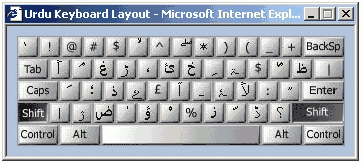Writing Urdu Text: In the past, both the web page programmer
and the casual reader had to use the same Urdu font. Typically,
this meant that the reader had to find a site from which to
download and install the same Urdu font that was used
by the Urdu writer in order to view the Urdu web
page. Thus, it is no longer necessary to download special Urdu fonts, since Urdu
characters are available in several Unicode fonts.
1. First, Windows 2000 has to be configured with the Windows Urdu keyboard.
The instructions to select a language keyboard are given
in Windows 2000: Language Settings.
2. Next, start the Microsoft Word 2000 —a word processing program.
3. Next, the EN
(English keyboard) has to be changed to the UR (Urdu keyboard) to type Urdu text. This selection is made by clicking
with the mouse on the EN
near the bottom right-hand corner of the monitor screen. After UR
has been selected, it should replace the EN
the bottom right-hand corner of
the monitor screen. The result is illustrated in the following
image.
4. The Urdu letters that will appear in the Word document will
correspond to Windows 2000 Urdu keyboard maps.


2. While in the Internet Options, click on Fonts
and click on the drop-down menu for Language script:. Select Arabic. Next select a font such as Times New
Roman or Arabic Transparent. Then
click OK.
If there are difficulties with Internet Explorer configurations, please let me know.
I have
not been able to do many tests.
Last edited 01-18-2002
